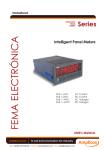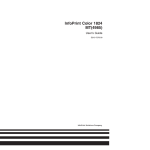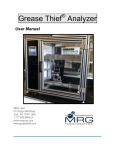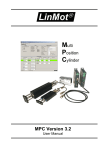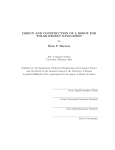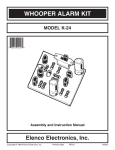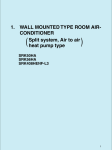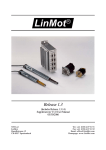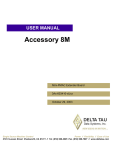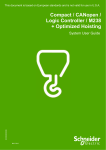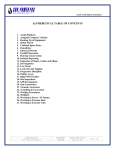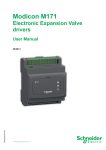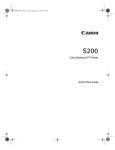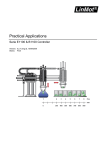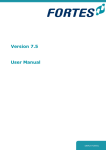Download English 1.49 MB
Transcript
® LinMot E110-VF / E210-VF / E1010-VF / E2010-VF User Manual 2.2 NTI AG LinMot Haerdlistrasse 15 CH-8957 Spreitenbach Switzerland Tel.: Fax: Email: Homepage: +41 (0)56 419 91 91 +41 (0)56 419 91 92 [email protected] www.LinMot.com © 2005 NTI AG This work is protected by copyright. Under the copyright laws, this publication may not be reproduced or transmitted in any form, electronic or mechanical, including photocopying, recording, microfilm, storing in an information retrieval system, not even for didactical use, or translating, in whole or in part, without the prior written consent of NTI Ltd. LinMot® is a registered trademark of NTI Ltd. Note The information in this documentation reflects the stage of development at the time of press and is therefore without obligation. NTI Ltd. reserves itself the right to make changes at any time and without notice to reflect further technical advance or product improvement. Please refer to the latest edition of our "General business terms" Document version 8/ as, July 2005 Table of Contents LinMot ® 1. Description and Features ...................................................................................... 5 1.1 Description............................................................................................................. 5 1.2 Features .................................................................................................................. 5 2. 2.1 2.2 2.3 2.4 2.5 2.6 2.7 Theory of Operation .............................................................................................. 6 Servo Loops ........................................................................................................... 6 Amplifier Types ..................................................................................................... 6 Master/Booster Operation...................................................................................... 7 Safety ..................................................................................................................... 7 Position Measurement............................................................................................ 7 Referencing ............................................................................................................ 8 Protection circuits .................................................................................................. 8 3. Installation.............................................................................................................. 9 3.1 Mechanical Dimensions of LinMot® Amplifiers ................................................... 9 3.2 Mechanical Installation of LinMot® Amplifiers .................................................. 10 3.3 Electrical Connection........................................................................................... 11 4. LinMot® Commander .......................................................................................... 19 4.1 Installation of LinMot®-Commander................................................................... 19 4.2 Upgrading Amplifier Firmware ........................................................................... 19 4.3 Logging into LinMot® Amplifier......................................................................... 20 4.4 4.5 4.6 4.7 4.8 Starting and Stopping the LinMot® Amplifier..................................................... 20 Configuration ....................................................................................................... 21 Variables Monitoring ........................................................................................... 21 Oscilloscope......................................................................................................... 22 Messages .............................................................................................................. 23 5. LinMot® Ex10-VF / Ex010-VF Parameters ....................................................... 24 5.1 System Parameters ............................................................................................... 24 5.2 Drive Parameters.................................................................................................. 25 6. 6.1 6.2 6.3 6.4 Amplifier Setup .................................................................................................... 33 Amplifier Mode ................................................................................................... 33 General Parameters .............................................................................................. 33 Force Control Mode ............................................................................................. 35 Velocity Control Mode......................................................................................... 36 A. Operating States................................................................................................... 43 B. Maintenance ......................................................................................................... 46 C. VF-Amplifier with ME01-Extension Module.................................................... 47 C.1 Wiring .................................................................................................................. 47 C.2 LED mimics ......................................................................................................... 47 Manual Ex10-VF / Ex010-VF V2.2 3 Table of Contents Manual Ex10-VF / Ex010-VF V2.2 LinMot ® 4 Description and Features LinMot ® 1. Description and Features 1.1 Description The LinMot® E110-VF, E210-VF, E1010-VF and E2010-VF servo amplifiers allow linear motors of the LinMot®-P series to be integrated very easily in existing motion controller multi-axis systems. In addition single phase actuators like DC-Motors can be controlled with this amplifier. • The integration of two independent drives into a single housing saves place and minimizes wiring. • Each amplifier channel accepts a bipolar DC control input. The amplitude of this signal may be used to control either the velocity or the current (force) of the connected LinMot® linear motor. • Basing on the integrated sensors of a LinMot® linear motor, the actual position is available as incremental position signal (A/B). • Each amplifier has several protection circuits to protect the amplifier, motor and operator from almost any kind of fault. Flashing LED show the type of fault occurred, and separate outputs can be used to send signals to other equipment. In addition the error or warn message can be read in plain-text by using the LinMot® Commander software. 1.2 Features • Ergonomic design: Easy configuration with Windows® based software tools. Easy access to connections. • Differential Inputs: Two independent low noise differential inputs accepting ±10VDC. • Dual mode operation: The amplifier may be configured for current (force) or velocity control. • Current Limit: Maximum motor current is adjustable. Two different levels can be selected with a digital input. • Fault and Warn output: Two digital outputs per motor channel monitor the status of the amplifier. Polarity of these signals can be configured. • Short circuit protection: Phase outputs are short circuit protected. • LED diagnostics: Green LED indicates normal operation condition, yellow LED indicates warnings and red LED indicate fault conditions. The yellow LED flashes in fault condition to display the actual fault. • Over/under voltage: These circuits monitor amplifier power-supply voltages constantly. They will shut down the amplifier in the event of any out-of-specification condition. • Over temperature: The motor and the amplifier-heatsink temperature is monitored constantly. The amplifier will be shut down in case of over temperature. Manual Ex10-VF / Ex010-VF V2.2 5 LinMot ® Theory of Operation 2. Theory of Operation 2.1 Servo Loops Most position control systems are arrangements of three control loops as shown in Figure 2-1: 1 The current loop directly influences motor acceleration and deceleration (force). The current loop is present in each amplifier. 2 The velocity loop supplies a velocity signal which becomes the demand signal for motor acceleration. Some amplifiers give the user the possibility to close the velocity loop inside the amplifier. 3 The position control loop is the over-riding motion loop. The position loop is generally closed by a third party motion controller and can not be closed inside the LinMot® VF-Amplifier. If the position loop must also be closed by LinMot® then LinMot® standard controllers (AT, MT, DP or DN family) must be used instead of VF-Amplifiers. Motor Command Position loop Velocity loop x v Current loop I Position encoder M E dx/dt Position Figure 2-1: Arrangement of the three essential loops for position control. 2.2 Amplifier Types Different types of amplifiers are known. In motion control systems velocitymode and force-mode amplifiers are most used. LinMot® VF-Amplifiers can be configured to operate in both of these modes. Velocity Loop Operation In this operation mode the two inner loops, the current loop and the velocity loop, are closed in the amplifier. The input signal of the amplifier is the demand velocity of the connected motor. Because the velocity loop tuning is load dependent, the velocity-loop of an amplifier must be tuned before the position loop is closed with an external position controller. Chapter 6 describes how to tune the velocity-loop of a LinMot® amplifier. Current Loop Operation In this operation mode only the current loop is closed in the amplifier. The input signal of the amplifier represents the demand force of the connected motor. The current loop on most amplifiers, also the LinMot® amplifiers, is already tuned at factory and doesn’t need to be tuned by the user. 6 Manual Ex10-VF / Ex010-VF V2.2 LinMot ® Theory of Operation 2.3 Master/Booster Operation Master/Booster operation enables the force available for a movement to be increased by putting motors in series or parallel. One motor must be defined as master, the other as booster. The moving part of the motors must be coupled mechanically. During operation all parameters for the booster motor are copied from the master motor. The current is calculated for the master motor only and set for both motors. A booster motor may work in the same or in the opposite direction as the master. This behavior can be chosen by selecting the type of actor. Master Master Booster reverse Booster parallel Figure 2-2: Master/Booster operating mode 2.4 Safety LinMot® amplifiers will energize the motors only if no error is pending and the Enable Input is activated. To ensure that the motors do not “jump” when the Enable Input gets activated the analog input signal (demand force or demand velocity) must be about 0V at this moment. For safety reasons the controller can deny a transition to RUN state if this signal is not in the range -1V..1V. This safety feature is disengageable. For a safe operation of linear motion-systems, motions in the end range of the allowed stroke must be monitored specially. This is normally done with limitswitches at both ends of the stroke. If the drive is moved into one of this switches the drive must be stopped immediately. The limit switch signals must be fed into the superior motion controller. 2.5 Position Measurement The accuracy of motion systems depends mainly on the implemented position measurement system. LinMot® linear motors have integrated position sensors basing on the measurement of the magnetic field of the slider. This method allows a position repeatability better than 0.1mm. The LinMot® Ex10-VF and Ex010-VF amplifier family outputs this information as quadrature (A/B) signal. The resolution of this simulated encoder outputs can be configured to 1µm, 2µm, 5µm, 10µm, 20µm or 50µm (4x sampling). Choosing a higher resolution does not increase the accuracy because the encoder simulation always works basing on the internal sensor system with the given repeatability. The incremental position outputs can provide frequencies up to 3MHz. This limits the max. velocity depending on the chosen resolution (3m/s @ 1µm). If Manual Ex10-VF / Ex010-VF V2.2 7 LinMot ® Theory of Operation the encoder rate is too high a warning is issued. Position increments could be lost if the allowed rate is exceeded. Position accuracy can be increased by using an external position sensor (incremental linear encoder) connected directly to the superior position controller. With high-end encoders, a position repeatability better than 1µm can be realized. If the VF-Amplifier is equipped with an ME01 Extension Module then the signal from an external position sensor can be used for position control (superior motion controller) and speed control (VF-Amplifier in velocity mode). See Appendix C. The external sensor system MS01 which is used for the LinMot® standard controllers (AT, MT, DP and DN) can not be used with the VF-Amplifier. 2.6 Referencing Most linear positioning system, including the LinMot® system, are based on incremental position measurement. A special reference sequence is necessary to define a reference position. This reference search must be accomplished by the superior position control system. LinMot® actuators can be referenced against a hard stop which will cause no harm to the motor. 2.7 Protection circuits LinMot® amplifiers monitor all important operation parameters like supply and temperature constantly. Any anormality will lead to a warning or error. A warning is issued and signaled with the Warn Output when any of the monitored parameters is in a critical range. The warning is cleared after the parameters are back in a save range. The warning signal can be used by the superior controller to move the motor to a save position before disabling. An error will shut down the amplifier if one of the monitored parameters is in an out-of-specification range. The ERROR state of the drive can only be left if all parameters are back in normal operation range and the Enable Input is inactive. 8 Manual Ex10-VF / Ex010-VF V2.2 LinMot ® Installation 3. Installation 3.1 Mechanical Dimensions of LinMot® Amplifiers The LinMot® Ex10-VF amplifiers do have the same mechanical dimensions as all other LinMot® standard controllers (AT, MT, DP or DN controllers) from the 100series. The mechanical dimensions of the Ex010-VF amplifiers correspond with the standard 1000series controllers. Fixings for 2 x M5 screws 179 Fixings for 2 x M5 screws ®-E2010 LinMot 120 Centers 315 ®-E210 LinMot 330 Centers 195 295 210 175 56 Dimensions in mm 64 70 Dimensions in mm 90 Figure 3-1: Mechanical dimensions of the LinMot® amplifiers Manual Ex10-VF / Ex010-VF V2.2 9 LinMot ® Installation 3.2 Mechanical Installation of LinMot® Amplifiers LinMot® amplifiers can be mounted with two screws (scew diameter 5mm, max. head diameter 10mm) on a panel. The LinMot® amplifiers must be mounted vertical to ensure good cooling. For space requirements please see the following drawings. Fixings for 2 x M5 screws 100 ® LinMot ® LinMot Maximal power dissipation: -E210 -E210 E110-VF 22W E210-VF 38W -E210 LinMot ® 100 50 50 50 100 50 Dimensions in mm Figure 3-2: Installation of Ex10-VF amplifier Fixings for 2 x M5 screws 100 ® LinMot ® LinMot ® LinMot -E2010 -E2010 -E2010 100 Maximal power dissipation: E1010-VF 55W E2010-VF 95W 50 50 50 100 Dimensions in mm 50 Figure 3-3: Installation of Ex010-VF amplifier 10 Manual Ex10-VF / Ex010-VF V2.2 LinMot ® Installation 3.3 Electrical Connection This chapter provides the information to make all the necessary electrical connections to the amplifier. Grounding IMPORTANT: The housing of the LinMot® amplifiers must be earth grounded. The ground of the power supplies must also be connected to earth at the same single point. In order to prevent any harm to the system the motion controller has to be grounded to the same level. Both, the LinMot® amplifier and the motion controller, must be connected to ground first before any other connections between them are installed. I/O Connector All I/O signals are available on the 25pin Sub-D style connector. Connector: Sub-D25 female. Pin Function Pin Function 1 Drive A: Analog In+ 14 Drive B: Analog In+ 2 Drive A: Analog In- 15 Drive B: Analog In- 3 Analog GND 16 Analog GND 4 Drive A: Enable In 17 Drive B: Enable In 5 Drive A: Current Limit In 18 Drive B: Current Limit In 6 Drive A: Fault Out 19 Drive B: Fault Out 7 Drive A: Warn Out 20 Drive B: Warn Out 8 +6V .. +24V DC I/O Supply 21 I/O GND 9 Drive A: Encoder Out A+ 22 Drive B: Encoder Out A+ 10 Drive A: Encoder Out A- 23 Drive B: Encoder Out A- 11 Drive A: Encoder Out B+ 24 Drive B: Encoder Out B+ 12 Drive A: Encoder Out B- 25 Drive B: Encoder Out B- 13 GND Position Outputs Table 3-1: Pin configuration of the Exx10-VF I/O connector Analog Control Inputs The analog control output of the motion controller and the input of the amplifier should be connected by a shielded cable to reduce noise pick-up. For a higher noise immunity the analog inputs are symmetrical. The control voltage is measured between the “Analog In+” and the “Analog In-” terminal. To avoid ground loops the analog grounds of the motion controller and the amplifier should not be connected together. If the motion controller provides symmetrical outputs, noise pick-up is eliminated mostly. The output voltage of some motion controllers (i.e. Delta-Tau PMAC) must be limited to ±10V DC between the positive and negative output. Manual Ex10-VF / Ex010-VF V2.2 11 LinMot ® Installation The following figure shows the wiring of the analog control signals for drive A: Motion controller with asymetrical outputs Controller E210-VF Out 1 GND 2 3 Motion controller with symetrical outputs Controller E210-VF Out+ 1 Out- 2 3 GND Figure 3-4: Analog control signal wiring Technical data of analog inputs: Resolution: Input voltage: abs. max. rating: Impedance: 12Bit -10V DC .. +10V DC -20V DC .. +20V DC 38kΩ Digital I/O Signals All digital I/O signals are optically isolated and can be operated between 5V and 24V DC. Digital outputs are built through overload protected high-side switches. The output drivers must be supplied externally. The logic high level of the digital outputs can be 2V less than the I/O supply voltage, depending on the load. The outputs are equipped with weak pull-down resistors internally. The required supply current depends on the load on the outputs. Technical data of digital inputs: Voltage: 0 .. 24V DC (abs. max. rating: -5 .. +28V DC) for logic low:<2V for logic high:>4V <20mA Current: Technical data digital outputs: I/O supply voltage: Output voltage: max. sourcing current: Pull-down resistors: max. sinking current: 6..28V DC 0..28V DC (depends on external supply) 0.5A 22kΩ 10mA @ 24V The following figure shows a typical wiring of digital I/O signals for drive A: Digital I/O Signals Controller E210-VF Enable out 4 GP output 5 Fault in 6 GP input 7 Supply in 8 GND 21 + I/O Supply Figure 3-5: Digital I/O signal wiring 12 Manual Ex10-VF / Ex010-VF V2.2 LinMot ® Installation Simulated Position Encoder Outputs The actual position of a LinMot® linear motor is available as an incremental quadrature signal on the Sub-D 25 connector. As electrical interface the RS422 / 5V standard is used. Quadrature Signals (only Motor A shown) Controller E210-VF Encoder A+ 9 Encoder A- 10 Encoder B+ 11 Encoder B- 12 Encoder GND 13 Figure 3-6: Wiring of position signals (Channel A shown) If a single phase actuator (DC motor, voice coil) is connected to a motor channel then the respective simulated encoder outputs of the amplifier must not be used. In this case the actuators position sensor is directly connected to the superior motion control system. Also if a LinMot® linear axis is equipped with a high accurate external position sensor, the simulated encoder outputs must not be used. The superior motion controller uses directly the external position sensor signals in this case. Serial Communication Interface The serial communication interface is used to configure the LinMot® Ex10-VF and Ex010-VF amplifiers. It can be directly connected to the RS232 port of any PC. Take care not to use a crossed (0-Modem) cable, but a cable connecting Pins 2,3 and 5 one to one. Connector: Sub-D 9, male Pin Function Pin Function 1 do not connect 6 do not connect 2 RS232_TX 7 do not connect 3 RS232_RX 8 do not connect / CAN_L 4 do not connect 9 do not connect / CAN_H 5 GND Table 3-2: Pin configuration on the Exx10-VF Com connector Power Supply Power supply inputs for signal electronics and motors are separated on both, the LinMot® Ex10-VF and Ex010-VF amplifiers. On machines whose actuators must be powered off in the event of an emergency shutdown for safety reasons, the motor supply can be switched off. By maintaining the signal supply, the position of the motor can still be captured. Manual Ex10-VF / Ex010-VF V2.2 13 LinMot ® Installation CAUTION: Exceeding the given absolut maximal rating voltages will harm the VF-Amplifier and the connected motors as well. Power supplies must be switched on and off on their primary side only. Ex10-VF Ex10-VF amplifiers are supplied via a single three-pole connector: matching socket: Phoenix PSC 1.5/3-F Pin Function Nominal Voltage Abs. max. rating 1 +Vcc signal supply +24V .. +48V DC +55V 2 Ground GND - 3 +Vcc motor supply +24 V.. +48V DC +55V Table 3-3: Pin configuration of the Ex10-VF PWR socket LinMot ®-E210 LinMot ®-E210 Mot A Mot A Supply 24 ... 48V DC Mot B Mot B Com Com PWR PWR + - Figure 3-7: Supply wiring of Ex10-VF Ex010-VF The Ex010-VF amplifier is supplied via two separate connectors. Signal electronics are supplied by a three-pole connector: matching socket: Phoenix PSC 1.5/3-F Pin Function Nominal voltage Abs. max. rating 1 +Vcc signal supply +24V..+48V DC +55V 2 Ground GND GND 3 do not connect Table 3-4: Pin configuration on Ex010-VF PWR Signal socket 14 Manual Ex10-VF / Ex010-VF V2.2 LinMot ® Installation Motors are supplied via a two-pole connector: matching socket: Phoenix MSTB 2,5/2-STF Pin Function Nominal voltage Abs. max. rating top Ground GND - bottom +Vcc motor supply +48V..+72V DC +80V Table 3-5: Pin configuration on Ex010-VF PWR Motor socket LinMot ®-E2010 LinMot ®-E2010 Mot A Mot A Mot B Mot B Signalsupply 24 ... 48 V DC Motorsupply 48 ... 72 V DC + + - Com - Com PWR PWR Motor Motor Signal Signal Figure 3-8: Supply wiring of Ex010-VF Motor Connection The actuator cables are plugged into the connectors found on the front panel of the amplifier marked as MOT A and MOT B. All necessary signals for one motor are integrated in a single connector. CAUTION: Incorrect connection of the actuators may lead to destruction of the amplifier and the motors. Disconnecting/reconnecting motors while the amplifier is powered on (even in DISABLE state) can damage the motor and the amplifier. For extension cables original LinMot® cables must be used only. Neither the LinMot® motor cables nor the standard LinMot® extension cables K01 are flex-cables. Wherever the active part of the motor (stator) is not fixed the special trailing chain cable KS01 has to be used. Manual Ex10-VF / Ex010-VF V2.2 15 LinMot ® Installation LinMot® Linear Motors Ex10-VF LinMot® linear motors are connected via 9-pin D-Sub sockets to an Ex10VF amplifier. Pin Color Signal 1 red phase 1+ 2 blue 3 Pin Color Signal 6 pink phase 1- phase 2+ 7 grey phase 2- white +5V 8 brown ground (GND) 4 yellow sine sensor 9 green cosine sensor 5 black temp. sensor Table 3-6: Pin configuration for the Ex10-VF motor socket Ex010-VF LinMot® linear motors are connected via 10-pin Mini-Combicom sockets to an Ex010-VF amplifier. Pin Color Signal Pin Color Signal 1 red phase 1+ 6 brown ground (GND) 2 pink phase 1- 7 yellow sine sensor 3 blue phase 2+ 8 green cosine sensor 4 grey phase 2- 9 black temp. sensor 5 white +5V - shielding 10 Table 3-7: Pin configuration for the Ex010-VF motor socket Single Phase Actuators Single phase actuators like DC-Motors or Voice Coils must be connected to phase 1 of the corresponding motor output. Their position sensor signals must be connected to the superior motion controller. On phase 2 of the motor output a bleeder resistor can be connected. Rotative DC-Motors tend to bring a lot of energy into the amplifiers DC link during deceleration. The back EMF can increase the DC link voltage over the maximum allowed limits (55V for Ex10-VF and 80V for Ex010-VF amplifiers) which leads to a transition to ERROR state. When the DC link voltage exceeds (in parameter tree definable) bleeding voltage the amplifier begins to bleed off power over this external brake resistor. The optional bleeder must have resistance according to the following table. The brake resistor should be able to draw 100W out of the DC link. Motor Power Supply Ex10-VF Ex010-VF 24V 8Ω - 48V 16Ω 8Ω 72V - 12Ω Table 3-8: Recommended bleeder resistance values For single phase actuators no other than the current output pins on the amplifiers motor socket must be used. 16 Manual Ex10-VF / Ex010-VF V2.2 LinMot ® Installation . Ex10-VF Pin Signal Pin Signal 1 motor phase + 6 motor phase - 2 optional bleeder phase+ 7 optional bleeder phase - 3 do not connect 8 do not connect 4 do not connect 9 do not connect 5 do not connect Table 3-9: Pin configuration for single phase actuators on LinMot® Ex10-VF motor socket Ex010-VF Pin Signal Pin Signal 1 motor phase + 6 do not connect 2 motor phase - 7 do not connect 3 optional bleeder phase + 8 do not connect 4 optional bleeder phase - 9 do not connect 5 do not connect 10 do not connect Table 3-10: Pin configuration for single phase actuators on LinMot® Ex010-VF motor socket Typical System Wirings The following figures show the typical system wiring for drive A on a VFAmplifier. Drive B is wired similarly. The system consists of the following components: • Motion controller • LinMot® Ex10-VF amplifier • LinMot® power supply • Actuator: LinMot® linear motor with or without external position sensor. • 6V .. 24V supply for I/O signals and motion controller Manual Ex10-VF / Ex010-VF V2.2 17 LinMot ® Installation Wiring of an Ex010-VF amplifier would be the same except for the extra motor power supply (48V..72V). MOTION CONTROLLER LinMot® Ex10-VF ENCODER VCC ENCODER GND ENCODER IN A+ ENCODER IN AENCODER IN B+ ENCODER IN B- 13: ENC. GND 9: ENC. OUT A+ 10: ENC. OUT A11: ENC. OUT B+ 12: ENC. OUT B- ANALOG OUT + ANALOG OUT ANALOG GND 1: ANALOG IN + 2: ANALOG IN 3: ANALOG GND AMP. ENABLE GP OUT AMP. FAULT GP IN 4: ENABLE IN 5: C. LIMIT IN 6: FAULT OUT 7: WARN OUT SUPPLY IO GND 8: VCC EXT. IO 21: IO GND MOT A PWR SIGNAL GND PWR MOTOR PSU LinMot® PSU MC +6V.24V DC GND +24V..48V DC GND Figure 3-9: Typical system wiring using the internal position measuring system of LinMot® linear motors MOTION CONTROLLER LinMot® Ex10-VF ENCODER VCC ENCODER GND ENCODER IN A+ ENCODER IN AENCODER IN B+ ENCODER IN B- 13: ENC. GND 9: ENC. OUT A+ 10: ENC. OUT A11: ENC. OUT B+ 12: ENC. OUT B- ANALOG OUT + ANALOG OUT ANALOG GND 1: ANALOG IN + 2: ANALOG IN 3: ANALOG GND AMP. ENABLE GP OUT AMP. FAULT GP IN 4: ENABLE IN 5: C. LIMIT IN 6: FAULT OUT 7: WARN OUT SUPPLY IO GND 8: VCC EXT. IO 21: IO GND PSU MC +6V..24V DC GND MOT A PWR SIGNAL GND PWR MOTOR PSU LinMot® +24V..48V DC GND Figure 3-10: Typical system wiring using an external position sensor. With high-end encoders a position repeatability better than 1µm can be realized. 18 Manual Ex10-VF / Ex010-VF V2.2 LinMot® LinMot ® Commander 4. LinMot® Commander The LinMot® Ex10-VF and Ex010-VF servo amplifiers are full digital controlled devices. They must be configured during the first commissioning. This is done with the Windows-based LinMot®-Commander. Before starting make sure that the amplifier is powered and the serial interface is connected to the PC with a one to one serial cable (female connectors on both ends). 4.1 Installation of LinMot®-Commander The new LinMot®-Commander software is a 32bit Windows® software. It runs on computers operating under Windows® 95, 98, NT4.0, 2000, ME and XP. The actual software release (V 2.2.x) is available from the LinMot® home page www.linmot.com. After downloading the software you can start “setup.exe” and follow the instructions in order to install the whole software package on your computer. The program can be started by clicking “Start” → “Programs” → “LinMot” → “LinMot® Commander 2.2.x”. 4.2 Upgrading Amplifier Firmware It is recommended to download the latest firmware version to the amplifier (V2.2.x). Downloading firmware will erase an eventually existing old configuration and will reset all parameter tree items to their default values. Start LinMot®-Commander, but don’t log in. Start the installation script by clicking the “Run Script” button : Figure 4-1: Starting the firmware download script In the file dialog select the new firmware installation file “Lm2R2Rx.sct” from folder “Cmdr2r2r0\Firmware\Lm2R2Rx\”. In the upcoming window the serial port which is used for updating the amplifier must be selected. Manual Ex10-VF / Ex010-VF V2.2 19 LinMot ® LinMot® Commander Figure 4-2: Successful download of all firmware components After successful installation close the “Package Installer” window. 4.3 Logging into LinMot® Amplifier To start the communication with a LinMot® amplifier connected to the serial port of your PC a login procedure is necessary. This can be done by opening the “File” menu and selecting “Login” or double-clicking on “Project”. In the upcoming dialog window the communication port can be selected. There can be only one LinMot® amplifier per serial port, but simultaneous communications with additional LinMot® amplifiers on different serial-ports is possible. Leave the password field empty. After successful login all features of the LinMot® amplifier can be accessed in a tree structure, similar to the Windows® file explorer. 4.4 Starting and Stopping the LinMot® Amplifier To set some configuration parameters, the software running on the amplifier must be stopped in advance (there will be a message dialog if it is necessary to stop the software). This can be done by clicking the “STOP” button shown in the picture below. Disable the servo loop on the superior controller and wait until the connected motors stand still before stopping the amplifier software. The “STOP” button will change to a “START” button when the amplifier software is stopped. Press this button to restart normal operation of the LinMot® amplifier. 20 Manual Ex10-VF / Ex010-VF V2.2 LinMot® LinMot ® Commander 4.5 Configuration All configuration parameters can be found under the “Configuration” folder. The parameters are arranged in a tree-structure. In the left pane the parameter group is chosen, on the right pane its value can be set. Figure 4-3: Editing of VF-Amplifier configuration All changes in the parameter settings are automatically copied into the non volatile memory of the amplifier. Some parameters can only be set if the software running on the LinMot® amplifier is stopped. So called Live Parameters (tagged with a superscript red L) can be altered during run time. E.g. the controller gain parameters are live parameters therefore the loop tuning can be done online. Some parameters are visible only under certain circumstances. E.g. the user doesn’t have the opportunity to configure Velocity Mode if Actuator Type is set to Single Phase Actuator. Drive A and B are configured independent from each other (except for Master/Booster operation). Parameters which affects the whole VF-Amplifier can be found in the \Information and \System folders. 4.6 Variables Monitoring In the “Variables Monitoring” folder important variables of the system and each drive can be monitored. Figure 4-4: Variables Monitoring feature Read Variable: By clicking on this button the value of the selected variable will be updated. Read All Variables: All variables listed in the right pane will be updated. Manual Ex10-VF / Ex010-VF V2.2 21 LinMot ® LinMot® Commander The updated values are valid only if the controller software has been running while the “Read” button has been pressed (the red “Stop” button is visible in this case). 4.7 Oscilloscope Figure 4-5: LinMot® Commander software oscilloscope The LinMot®-Commander software oscilloscope is a very helpful tool for commissioning a LinMot® drive system. The buttons in the Oscilloscope pane do have the following functionality: Setting: After pressing this button the user can do the setting for his measurements: Choosing the variables to be observed, setting the recording time, defining trigger conditions and setting different display options. Start: If no trigger condition is set the recording of the selected variables immediately begins after pressing the start button. If additional trigger conditions are defined then the controller starts the measuring the first time the conditions are fulfilled. Fit View: The “Fit View” feature automatically sets scale and offset of the oscilloscope display in order to show all recorded data in the display window. Zoom in/out: Instead of adjusting the offset and scale manually (Setting window) in order to see some data more in detail the zoom functions may be used. Export: The measured data can be saved to disk in Comma Separated Values (csv) format for further evaluation (e.g. with MS Excel, Matlab etc.). 22 Manual Ex10-VF / Ex010-VF V2.2 LinMot® LinMot ® Commander 4.8 Messages The amplifier monitors the drive operational states and all critical parameters constantly. If one of them is out of the specification range a warning or an error message is generated and signalled to the superior control with digital I/O signals. The LinMot® amplifiers stores events internally with a time stamp (state transitions, warnings, errors). Warnings and errors enabled in the Logging mask are also stored in the nonvolatile memory. With the LinMot® Commander Message-Service the events stored and logged in a LinMot® amplifier can be viewed in plain text. Figure 4-6: Observing state transitions and warning/error events with the Messages tool The messages stored in the nonvolatile memory are marked with “(logged)”. Manual Ex10-VF / Ex010-VF V2.2 23 LinMot ® LinMot® Ex10-VF / Ex010-VF Parameters 5. LinMot® Ex10-VF / Ex010-VF Parameters In this chapter you will find short descriptions of the configuration parameters. Following signs are used in the tables below: Read-only parameter, user cannot alter this parameter. Live parameter, this parameter can be altered during operation. This symbol indicates that the parameter is visible only under certain circumstances. 5.1 System Parameters DCLV Monitoring In this folder the DC link voltage levels which can generate warnings and errors are defined. Exceeding the ranges will activate the Warn Output and the Error Output if the corresponding items in the drive specific Warn and Error Detection Mask are selected (see below). \Configuration\System\DCLV Monitoring 24 Motor supply low warn When the motor supply voltage sinks below this level (default 21V for Ex10-VF, 42.2V for Ex010-VF) the warning condition is fulfilled. Motor supply high warn When the motor supply voltage exceeds this level (default 50.6V for Ex10-VF, 76.3V for Ex010-VF) the warning condition is fulfilled. Motor supply low error When the motor supply voltage sinks below this level (default 18.2V for Ex10-VF, 36.5V for Ex010-VF) the fault condition is fulfilled. Motor supply high error When the motor supply voltage exceeds this level (default 53.4V for Ex10-VF, 79.6V for Ex010-VF) the fault condition is fulfilled. Signal supply low warn When the motor supply voltage sinks below this level (default 21V) the warning condition is fulfilled. Signal supply high warn When the motor supply voltage exceeds this level (default 50.6V) the warning condition is fulfilled. Signal supply low error When the motor supply voltage sinks below this level (default 18.2V) the fault condition is fulfilled. Signal supply high error When the motor supply voltage exceeds this level (default 53.4V) the fault condition is fulfilled. Manual Ex10-VF / Ex010-VF V2.2 LinMot® Ex10-VF / Ex010-VF Parameters LinMot ® 5.2 Drive Parameters Motor Type This parameter defines the type of the connected actuator. \Configuration\Drive x\Motor type No motor no actuator connected LinMot P0x-23 LinMot® Motor of the P0x-23 family LinMot P0x-37 LinMot® Motor of the P0x-37 family Single phase actuator Single phase actuator like DC-Motors, Voice-CoilMotors or Magnets Parallel Booster Motor B is a booster working in the same direction as motor A. 1) Reverse Booster 1) Motor B is a booster working in the opposite direction as motor A. 1) Visible only for drive B and only if drive A motor type is LinMot P0x Amplifier Setup In this folder the amplifier mode and control parameters are set. For further description of the controller loops see chapter 6. Amplifier Mode With the Amplifier Mode parameter the user can select which servo-loops are closed inside the LinMot® amplifier. \Configuration\Drive x\Amplifier setup\Amplifier mode Force Only the current loop is closed inside the amplifier. The output current is proportional to the analog command signal. Velocity The current and velocity loops are closed inside the amplifier. The velocity of the connected linear motor is proportional to the analog command signal. 1) 1) Visible only if motor type is LinMot P0x Manual Ex10-VF / Ex010-VF V2.2 25 LinMot ® LinMot® Ex10-VF / Ex010-VF Parameters Control Parameters Depending on the selected amplifier mode different control parameters can be set. \Configuration\Drive x\Amplifier setup\Control parameters Maximum current Sets the maximum current applied to the motor. This parameter also determines the maximum force the motor can provide. Maximal current also depends on the motor type and supply voltage. Unit: A Current offset Offset current used to compensate static forces such as gravity in vertical applications. Unit: A Current limit (CL Input) Set the maximal current applied to the motor when the Current Limit input is active. Unit: A Current gain 1) Ratio between input voltage and output current (demand motor current at +10V input). Unit: A Velocity gain 2) Ratio between input voltage and demand velocity (demand velocity at +10V input). Unit: m/s P-Gain velocity loop 2) Determines how the difference between demanded velocity and actual velocity is represented by current command value. Unit: A/(m/s) I-Gain velocity loop 2) FF Acceleration 2) Determines how the time integral of velocity deviation is represented by the current. Unit: A/(m/s)/s Determines which current must be fed forward to obtain the desired acceleration. Unit: A/(m/s^2) FF Friction 2) Determines which current must be fed forward to compensate dry friction. Unit: A 1) Visible only if the force mode is selected. 2) Visible only if the velocity loop is closed in the LinMot® amplifier. 26 Manual Ex10-VF / Ex010-VF V2.2 LinMot® Ex10-VF / Ex010-VF Parameters LinMot ® Advanced Settings The parameters in the Advanced Setting folder may be modified only by advanced users with expert knowledge in control theory. \Configuration\Drive x\Amplifier setup\Advanced settings Analog In offset With this parameter an offset to the analog command input can be added or subtracted. Unit: V FF Acceleration dead band 1) Currents caused by the FF Acceleration network smaller than this value are suppressed. Noise introduced by derivation of the demand speed signal can be reduced with this parameter. Unit: A FF Friction dead band 1) The FF Friction network does fully affect the controller output only if the analog command input (demand velocity) is greater than this value (noise suppression while standstill of the motor). Unit: V Actual speed dead band 1) If the actual speed is less than this value then the actual speed is set to zero. Noise introduced by derivation of the actual position can be reduced with this parameter (noise suppression while standstill of the motor). Unit: m/s Integrator limit 1) This value limits the velocity control loop integrator capacity. The demand current part caused by the IGain is limited in order to suppress position over shoots. Unit: A Bleeder voltage 2) If the motor supply DC link voltage exceeds this level the amplifier begins to bleed off power over the optional external brake resistor. Unit: V 1) Visible only if the velocity loop is closed in the LinMot® amplifier. 2) Visible only if Single Phase Actuator is selected. Manual Ex10-VF / Ex010-VF V2.2 27 LinMot ® LinMot® Ex10-VF / Ex010-VF Parameters Position Capturing When high performance in the position control is required then the LinMot® linear motor axis has to be equipped with an additional external position sensor. The signals of this sensor are used from the superior motion control system for closing the position control loop. If the LinMot® VF-Amplifier is equipped with an ME01 extension module the same external sensor signals can also be used for position and speed capturing in the LinMot® VFAmplifier. This makes sense only for axes in velocity control mode. See also Appendix C. If the VF-Amplifier is not equipped with a ME01 extension module (as usual) the “Internal sensor” check box must be selected. . \Configuration\Drive x\Position capturing Internal sensor 1) External AB encoder 1um 2) External AB encoder 2um 2) External AB encoder 5um 2) External AB encoder 10um 2) External AB encoder 20um 2) Position capturing based on the internal position measuring system. If no ME01 extension module is used this item must be checked. Position capturing based on an external AB linear encoder with 1µm resolution connected to the ME01 extension module. Position capturing based on an external AB linear encoder with 2µm resolution connected to the ME01 extension module. Position capturing based on an external AB linear encoder with 5µm resolution connected to the ME01 extension module. Position capturing based on an external AB linear encoder with 10µm resolution connected to the ME01 extension module. Position capturing based on an external AB linear encoder with 20µm resolution connected to the ME01 extension module. 1) This parameter is only visible if a LinMot® linear motor type is selected. 2) Visible only if the velocity loop is closed in the LinMot® amplifier. 28 Manual Ex10-VF / Ex010-VF V2.2 LinMot® Ex10-VF / Ex010-VF Parameters LinMot ® Encoder Simulation This parameter sets the resolution of the simulated encoder output signals. The encoder simulation is always based on the internal position measuring system of the LinMot® linear motor. The max. speed depends on the selected resolution. If this value is exceeded a warning is generated. \Configuration\Drive x\Encoder simulation 1um 1) 2um Position is put out in 1µm increments max. speed: 2.5m/s 1) Position is put out in 2µm increments max. speed: 5m/s 5um Position is put out in 5µm increments 1) 10um Position is put out in 10µm increments 1) 20um Position is put out in 20µm increments 1) 50um Position is put out in 50µm increments 1) 1) This parameter is only visible if a LinMot® linear motor type is selected. I/O Logic Definition These parameters modify the active level of the digital I/O signals. \Configuration\Drive x\I/O logic definition Invert Enable In If this parameter is checked, the Enable Input becomes low active. Invert CL In If this parameter is checked, the Current Limit (CL) Input becomes low active. Invert Fault Out If this parameter is checked, the Fault Output is set high during normal operation and low when the drive is in ERROR state. Invert Warn Out If this parameter is checked, the Warn Output is set high during normal operation and low in the case of a pending warning. Manual Ex10-VF / Ex010-VF V2.2 29 LinMot ® LinMot® Ex10-VF / Ex010-VF Parameters Errors and Warnings The LinMot® amplifier firmware constantly monitors all important operation parameters. Deviations from save operation state are indicated to the superior control system with digital outputs (Warn and Fault output). Error Detection Mask With the Error Detection Mask the user can decide which internal error conditions lead to ERROR state transition (motor will be switched off, Fault Out activated and a respective error message generated). \Configuration\Drive x\Position capturing\Errors and Warnings\Error detection mask Motor type mismatch This error is set if the connected motor type does not match with the selection in the parameter tree. Slider missing This error is set if the amplifier can’t detect a slider in the LinMot® linear motor stator. 1) Amplifier thermal overload The temperature of the power electronics in the amplifier is monitored constantly. If the VF-Amplifier is too hot it will shut down. Motor overload (calculated) Based on the output current the amplifier estimates the actual motor temperature. If the motor is too hot calculated this error is set. With this feature crash situations can be detected faster than with the hardware sensor. This item should be deselected only if this error occurs sometimes during normal operation (no crashes). The motor is then running near its thermal limit. 1) Motor overload (temp sensor) 1) 30 LinMot® linear motors are equipped with integrated temperature sensors. If a connected motor gets too hot this error is set and the motor channel is switched off. Signal supply too low If the signal supply voltage sinks below the defined level2) the drive is shut down. Signal supply too high If the signal supply voltage rises over the defined level2) the drive is shut down. Motor supply too low If the motor supply voltage sinks under the minimal specified level2) the drive is shut down. Manual Ex10-VF / Ex010-VF V2.2 LinMot® Ex10-VF / Ex010-VF Parameters LinMot ® \Configuration\Drive x\Position capturing\Errors and Warnings\Error detection mask Motor supply too high If the motor supply voltage rises over the maximal specified level2) the drive is shut down. External position sensor error External position sensor is not available. The ME01 module not supplied or not existent at all. With a ME01-01/08 module an external position sensor is available only on channel A. 3) Master/Booster error An error on the booster leads to ERROR state on the master motor. 4) Start permission error The transition to RUN state is denied if analog command input is not in the range of -1V..+1V when enable input becomes activated. 1) This parameter is visible only if a LinMot® linear motor type is selected. 2) The level can be set at \Configuration\System\DCLV Monitoring 3) This parameter is visible only if the usage of an external AB encoder is selected. 4) This parameter is visible only on Drive A if Motor Type of Drive B is set to be a Booster motor. Warn Detection Mask With the Warn Detection Mask the user can decide which internal warn conditions activate the Warn Output and generate a warn message. \Configuration\Drive x\Position capturing\Errors and Warnings\Warn detection mask Motor overload (calculated) 1) Motor overload (temp sensor) 1) Based on the output current the amplifier estimates the actual motor temperature. If the estimated temperature becomes high a warning is generated. LinMot® linear motors are equipped with integrated temperature sensors. If a connected motor gets hot this warning occurs some seconds before the axis goes to the ERROR state. Signal supply low If the signal supply voltage sinks below the defined level2) a warning is generated. Signal supply high If the signal supply voltage exceeds the defined level2) a warning is generated. Motor supply low The amplifier generates a warning if the motor supply voltage sinks under the defined warn level2). Motor supply high The amplifier generates a warning if the motor supply voltage rises over the defined warn level2). Encoder output frequency high This warning is activated if the encoder rate is near the limit (3 MHz) 1) This parameter is visible only if a LinMot® linear motor type is selected. 2) The level can be set at \Configuration\System\DCLV Monitoring Manual Ex10-VF / Ex010-VF V2.2 31 LinMot ® LinMot® Ex10-VF / Ex010-VF Parameters Error / Warn Logging Mask These masks determine which errors and warnings are logged in the non volatile memory of the LinMot® amplifier. Only errors and warnings which are selected in the respective Detection Masks are visible and may be logged. 32 Manual Ex10-VF / Ex010-VF V2.2 LinMot ® Amplifier Setup 6. Amplifier Setup The LinMot® amplifier needs to be tuned to obtain good results. This chapter shows how a good setup can be achieved. 6.1 Amplifier Mode First of all the user has to decide which amplifier mode, force or velocity, will be used. The decision either for force or velocity mode depends mainly on the given interface from the superior control system. If the analog controller output is explicitly stated to represent Demand Velocity then velocity mode is preferrably chosen. If the output is explicitly stated to be a Demand Force signal the force mode has to be selected. If it is unclear or if the user has the possibility to choose the output format then force mode is more favorable because of the following reasons: • In force mode all essential tuning parameters are located in the same system, the superior motion controller. This makes the loop tuning much easier and more comfortable for the user. • LinMot® linear motors are mainly used for high dynamic positioning. Because the stroke of a linear motor is always limited they never have to run for a long time with constant speed (in contrast to traditional rotative electric motors). When high dynamic motions are required the velocity control loop looses its relevance. A fast position control loop is more important in this case. • Because LinMot® linear motors don’t have an extra velocity measuring system (in contrast to some rotative motors with extra tachometer generator) the actual velocity value has to be calculated through derivation of the position sensor signals. Derivation always causes additional noise in the system which may decrease the control performance. The more noisy the position signal is the more noisy will the actual velocity signal be. By using an external position sensor fed into a LinMot® ME01 extension module (see Appendix C) the noise level in velocity mode can be reduced. In force mode the usage of a ME01 module is not necessary even for high performance position control with external position sensor, because in this mode no derivation of the actual position signal is used by the VF-Amplifier. • Especially when high load masses are attached to a LinMot® linear motor it is very important to feed forward the required current for the acceleration of the load mass. In velocity control mode FF Acceleration has to be calculated in the LinMot® amplifier. The required demand acceleration information has to be calculated by derivation of the analog input signal. Derivation increases noise and therefore brings additional noise into the servo system. 6.2 General Parameters The visibility of most of the control parameters depends on the selected amplifier mode (force or velocity). But there are a few valid in both modes. Manual Ex10-VF / Ex010-VF V2.2 33 LinMot ® Maximum Current Amplifier Setup The user has to set the maximal current which depends on the used LinMot® linear motor type and the supply voltage. The following values are recommended: Ex10-VF Motor type 24V Ex010-VF 48V 48V 72V P0x-23x80 2.0 A 3.0 A 3.0 A 3.0 A P0x-23x160 1.0 A 2.0 A 2.0 A 2.8 A P0x-37x120 - 3.0 A 6.0 A 6.0 A P0x-37x240 - 3.0 A 3.3 A 5.0 A Table 6-1: Recommended maximum current setting Setting higher values tends to worse controller performance. If smaller values are used the peak force of the motor (see data sheet) can not be achieved. If for safety reasons (e.g. during the commissioning process) the maximal motor force has to be limited then the user can set smaller values here. Offset Current The offset current is used to compensate static forces. In general the following formula has to be used to determine the offset: F ST OffsetCurrent = -------cf Where FST is the static force [N] and cf the force constant [N/A] of the implemented LinMot® linear motor. The cf factor can be found in the LinMot® data sheets1. The offset current must be set in vertical applications in order to compensate gravity to get a better servo performance. The value can be calculated by using the following formula: m×g OffsetCurrent = -------------cf Where m is the moved mass (payload and moved part of motor) in kg, g is the acceleration due to gravity (9.81m/s2). The sign of the parameter depends on the direction of the mounting. If the motor cable exit is in direction to the floor then the sign is positive otherwise it must be set negative. Current Limit The motor current is limited with the Maximum Current parameter in general. But in some application it is necessary that the motor current is further limited, not for the whole cycle but temporarily. This is necessary e.g. for assembly applications where parts have to be pressed into others with limited force. With the Current Limit parameter the user can define a second current limitation which is considered only when the CL Input gets active. Setting this parameter greater than the Maximum Current parameter doesn’t make sense because the Maximum Current limitation has higher priority. 1) In Master/Booster mode the motor force constant must be mulitplied by two. 34 Manual Ex10-VF / Ex010-VF V2.2 LinMot ® Amplifier Setup 6.3 Force Control Mode . Current Offset Analog In Current_Gain 10V Demand Current (unlimited) + Demand Current + Max. Current Figure 6-1: Force Control Network The current control loop is already tuned at factory and can not be changed by the user. The user must only set the Current Gain parameter which defines the gain from the input voltage to the demanded motor current. Current Gain In general the Current Gain parameter should be set to the same value as the Maximum Current parameter in order to prevent any saturation effects. Demand Current (unlimited) +Current_G. -10V Analog In +10V -Current_Gain Figure 6-2: Relation between analog input signal and demand motor current in force control mode There aren’t further control parameters to be set in the force control mode on LinMot® amplifier side. All further control loops are part of the superior control system and must be tuned according to the corresponding user manual. If the superior motion control system has a control structure which allows setting a load dependent FF Acceleration and/or FF Friction then these features should be utilized. Especially feeding forward of acceleration might improve the position controller performance. Manual Ex10-VF / Ex010-VF V2.2 35 LinMot ® Amplifier Setup 6.4 Velocity Control Mode Velocity Control Network The velocity control network consist of a PI controller and feed forward path for acceleration and friction compensation. The Demand Current is the sum of Current Offset, FF Acceleration current, FF Friction current and the output of the PI network. Current Offset Demand Acceleration d/dt + + FF_Acc. Derivative ++ Demand Direction FF_Fric. sign Analog In Speed Deviation Vel._Gain 10V Dem. Speed +- P_Gain + + + Demand Current + Max. Current dt I_Gain Integrator Actual Position Actual Speed d/dt Derivative Figure 6-3: Velocity Control Network Velocity Gain 36 With the Velocity Gain parameter the relation between analog command input and demanded velocity is determined. Enter here a value which is at least 10% above the maximal from the application required velocity (to get at least 10% control reserve). Actually check how fast the LinMot® can move in your application. Too high values will decrease the controller performance. On the other hand the Velocity Gain parameter should not be set too high in order not to lose resolution on the Demand Speed signal. Manual Ex10-VF / Ex010-VF V2.2 LinMot ® Amplifier Setup The Velocity Gain parameter should not exceed twice the maximum speed of the application. Demand Speed +Velocity_G. Analog In -10V +10V -Velocity_Gain Figure 6-4: Gain from analog input signal to demand velocity In order to achieve good control performance the analog control signal must represent the same demand velocity on both systems, the LinMot® amplifier and the superior position control system. FF Acceleration The FF Acceleration path generates a current depending on the demanded acceleration. This helps the controller to achieve a better performance. The FF Acceleration value can be calculated with the following formula: m FF Acceleration = ----cF Where m is the moved mass (payload and moved part of motor) in kg and cf the force constant [N/A] of the implemented LinMot® linear motor. The correct value for cf can be found in the corresponding data sheet of the motor1. FF Friction The FF Friction path generates a current which can compensate dry friction forces. If there is a noteworthy friction in the system then the FF Friction value can be calculated using the following formula: FFR FF Friction = --------cF Where FFR is the friction force in Newton and cf the force constant [N/A] of the used LinMot® linear motor (data sheet)1. The FFR can be measured with a spring scale (electrically unplugged motor). If there is only little friction in the system the FF Friction value may be set to zero. P and I Gain velocity loop The P and the I Gain are the tuning parameters of the PI velocity controller. The P gain (proportional gain) generates a current which is proportional to the difference between the demanded and actual velocity (speed deviation). The I gain (integral gain) corrects automatically any static deviations in the velocity control loop. The integral gain cumulates the velocity difference over the time, i.e. the longer the difference exists the more current is generated by the integrator. For applications where high dynamic positioning is required the I gain should be set to zero, otherwise the I gain could lead to unacceptable overshoots. But setting an I gain can distinctly improve the control performance when slow motions are required. 1) In Master/Booster mode the motor force constant must be mulitplied by two. Manual Ex10-VF / Ex010-VF V2.2 37 LinMot ® Amplifier Setup Velocity Mode Controller Setup If velocity control mode is used the inner control loop (velocity loop) must be tuned first, preferably independent from the superior position control loop. Open Loop Position Control For tuning the velocity loop the superior controller must be running in open loop mode. In open loop mode the demand velocity output of the position controller is driven only by the velocity feed forward path (FF Velocity gain parameter) of the motion controller. All other control parameters in the superior system (typically PID and FF Acceleration) must be set to 0 in order to avoid influence to the controller output. If the superior controller doesn’t offer open loop mode an external signal generator is necessary. . Motion Profile Generator a Demand Acceleration v FF_Acc. Demand Speed + FF_Veloc. d/dt + + Analog Output D Derivative x Dem. Position +- Pos. Deviation dt P + + + I Integrator Actual Position Figure 6-5: Structure of a typical motion controller. To achieve open loop control the PID gains and the FF Acceleration gain must be set to zero. For tuning the velocity loop a trapezoidal demand velocity signal must be generated by the superior motion controller running in open loop mode. The trapezoidal demand velocity represents an application typical point-topoint movement with defined max. acceleration (steepness of trapezoid edges) and velocity (height of trapezoid). If it is impossible to generate this signal with the superior controller you may use an external signal generator instead. Keep in mind that the area under the demand speed profile is equal to the demand stroke. 38 Manual Ex10-VF / Ex010-VF V2.2 LinMot ® Amplifier Setup Figure 6-6: Trapezoidal demand speed signal Velocity Controller Tuning Start with setting the FF Friction and FF Acceleration parameters according to the given formulas (see above). Set the P Gain of the velocity loop to a small value (e.g. 1A/(m/s)) and I Gain to 0. Figure 6-7: Speed following with correctly set Feed Forward parameter but insufficient P Gain If the Feed Forward (FF) parameters are calculated correctly then the Actual Speed signal follows more or less to the Demand Speed signal. After testing that the FF parameters are set correctly you can increase the P Gain in steps of 0.5A/(m/s) until the Actual Speed signal is congruent with the Demand Speed signal. If the P Gain is increased too much the motor becomes louder. Further increasing could even lead to instability! Manual Ex10-VF / Ex010-VF V2.2 39 LinMot ® Amplifier Setup Typically the optimum between good speed following and few noise production will be achieved with P Gains between 3A/(m/s) and 15A/(m/s). Figure 6-8: Result after tuning the velocity control loop If the internal motor position sensor is used the captured velocity signal is noisy. In this case look at the average and not at single overshooting peaks. This noise occurs because the velocity signal is calculated out of the position feedback. Direct driven linear motors can not be equipped with tachogenerators for a smooth velocity feedback. With an external position sensor signal fed into a ME01 extension module (see Appendix C) the noise on the actual speed signal can be reduced. For slow motions setting an I Gain can be helpful. If even with high P Gain value (over 15A/(m/s)) no acceptable following of the Actual Speed can be achieved it is advisable to add an I Gain. In this case start with an I Gain of 30A/(m/s)/s. Increase this value then in steps of 10A/(m/s)/s until good speed following is achieved. For slow movements I Gain values about 100200A/(m/s)/s are realistic. Too high integral gains will lead to overshoot in velocity and position. Closed Loop Position Control After the velocity control loop is tuned the superior position control loop has to be closed. For tuning the position control loop follow the instructions given in the user manual of the motion controller. 40 Manual Ex10-VF / Ex010-VF V2.2 LinMot ® Amplifier Setup With a good position controller setup positioning without over shoot is possible. Figure 6-9: Positioning without overshoot after closing the superior position control loop Manual Ex10-VF / Ex010-VF V2.2 41 LinMot ® 42 Amplifier Setup Manual Ex10-VF / Ex010-VF V2.2 LinMot ® Operating States A. Operating States Each motor channel of a LinMot® VF-Amplifier is equipped with three LED’s. Different operating states and errors are displayed with blink patterns. The two drives on E210-VF and E2010-VF work independently from each other and may be in different operating states at the same time. FIRMWARE STOPPED Power Up | STA Error LED Off Warn LED Blinking Ready LED On STO STO SETUP STO !MC MC NO MOTOR CONFIGURED WAIT FOR DISABLE Transition Condition/Logic Operation Shortcut !EN ERROR PENDING EP ENABLE INPUT ACTIVE EN EP STO DISABLE !EP & !EN !EN STO EN EP ERROR RUN MOTOR CONFIGURED MC SOFTWARE START COMMAND STA SOFTWARE STOP COMMAND STO LOGIC OR | LOGIC AND & LOGIC NOT ! EP Figure A-1: Operating States Diagram FIRMWARE STOPPED This state is entered when the user clicks on the “STOP” button in the LinMot® commander or after the firmware upgrade. In this state all six LED’s are lit. The state can be left by clicking the “START” button in the LinMot® commander or by powering off and on the signal supply of the controller. NO MOTOR CONFIGURED If no motor is configured on a motor channel the respective Error LED (red) and the Ready LED (green) are dark. The Warn LED (yellow) is lit. WAIT FOR DISABLE For safety reasons transition to normal operating states is possible only if the Enable Input is inactive. If the Enable Input is active at firmware start or power up then the axis stays in WAIT FOR DISABLE state as long as the Enable Input keeps active. In the WAIT FOR DISABLE state the Warn and the Ready LED are lit. The Error LED is switched off. Manual Ex10-VF / Ex010-VF V2.2 43 LinMot ® Operating States DISABLE If the axis is disabled the green LED flashes twice, followed by a longer pause. Any warnings are displayed by a blink pattern on the yellow LED according to the table on the next page. The Error LED is dark. RUN When the amplifier is enabled and the motors are powered the Ready LED is lit continuously. Any warnings are displayed by a blink pattern on the yellow LED (see following table). The Error LED is dark. ERROR If an amplifier channel has a fault condition the red LED is blinking. Slow blinking (~0.5Hz) indicates an amplifier specific error (both motor channels may be affected), faster blinking (~2Hz) indicates a motor specific fault condition. The yellow LED displays the type of error with flash codes according to the following table As long as any error conditions are pending the green LED is dark. If there are no further errors pending, but the Enable Input is active, then the lit Ready LED displays that the axis is ready for the transition to the DISABLE State. For safety reasons the transition directly to RUN State is not possible. 44 Manual Ex10-VF / Ex010-VF V2.2 LinMot ® Operating States Error LED Warn LED Ready LED Description on on on FIRMWARE STOPPED state. off on off NO MOTOR CONFIGURED state. off on on WAIT FOR DISABLE state. off off 2x blinking DISABLE state. No warning pending. off off on RUN state. No warning pending. off 1x blinking 2x blinking: DISABLE state DISABLE/RUN state. Warning: The supply voltage for the power circuitry is low. on: DISABLE/RUN state. Warning: The supply voltage for the power circuitry is high. 2x blinking ~0.5Hz blinking 3x blinking DISABLE/RUN state. Warning: The supply voltage for the signal circuitry is low. 4x blinking DISABLE/RUN state. Warning: The supply voltage for the signal circuitry is high. 5x blinking DISABLE/RUN state. Warning: Motor overload (calculated). 6x blinking DISABLE/RUN state. Warning: Motor overload (temp sensor). 7x blinking DISABLE/RUN state. Warning: Encoder output frequency high. 2x blinking 3x blinking 4x blinking ~2Hz blinking RUN state off: Error pending DCLV Error: The supply voltage for the power circuitry is too low. on: Error reason disappeared, ready for transition to DISABLE state. DCLV Error: The supply voltage for the power circuitry is too high. DCLV Error: The supply voltage for the signal circuitry is too low. 5x blinking DCLV Error: The supply voltage for the signal circuitry is too high. 6x Amplifier Error: Amplifier too hot or short circuit. blinking 1x blinking off: Error pending 2x blinking Motor Error: The motor is overloaded (calculated). Motor Error: The motor is overloaded (temp sensor). on: Error reason disappeared, ready for transition to DISABLE state. 3x blinking 4x blinking 5x blinking Motor Error: Master or Booster motor failed. 6x blinking Motor Error: External position sensor is not available. 7x blinking Motor Error: Start permissive denied. Transition to RUN state not possible because analog input signal was not in range -1V..+1V. Motor Error: Slider missing. Motor Error: Motor type mismatch or motor damaged. Table A-1: LED Codes Manual Ex10-VF / Ex010-VF V2.2 45 LinMot ® Maintenance B. Maintenance The supply inputs of LinMot® VF-Amplifiers are equipped with fuses against overcurrent. On the power electronic boards two glass fuses are placed. One for the motor supply and one for the signal supply. If after consultation with the LinMot® support team it turns out that one of the fuses must be replaced the following fuse types have to be used: Ex10-VF S301 S302 Figure B-1: Fuses on the LinMot® Ex10-VF power electronic board Fuse Type S301, Motor supply 10A slow, ∅ 5mm x 20mm S302, Signal supply 0.5A slow, ∅ 5mm x 20mm Ex010-VF S2 S1 Figure B-2: Fuses on the LinMot® Ex010-VF power electronic board 46 Fuse Type S1, Motor supply 10A slow, ∅ 5mm x 20mm S2, Signal supply 0.5A slow, ∅ 5mm x 20mm Manual Ex10-VF / Ex010-VF V2.2 LinMot ® VF-Amplifier with ME01-Extension Module C. VF-Amplifier with ME01-Extension Module For high performance velocity control the signals from an external AB incremental position sensor may be used for velocity capturing. C.1 Wiring The VF-Amplifier can be equipped with an ME01 extension module with either one (ME01-01/08) or two (ME01-02/08) encoder inputs. The encoder connected to the upper encoder input socket can be used for velocity control of Drive A, the second for Drive B (ME01-02/08 only). The wiring of an ME01 module is shown below. Further description of the ME01 module can be found in the brochure “Master Encoder Interface” (available from www.linmot.com). The ME01 module must be supplied with 24VDC. This extension module mounted on a VF-Amplifier handles AB incremental encoders with RS422 signal level. The digital IOs on the 25pin Sub-D style connector are reserved for future application specific software extensions. MOTION CONTROLLER ENCODER VCC ENCODER GND ENCODER IN A+ ENCODER IN AENCODER IN B+ ENCODER IN B- 5: ENC. GND 6: ENC. IN A+ 2: ENC. IN A7: ENC. IN B+ 3: ENC. IN B- ANALOG OUT + ANALOG OUT ANALOG GND 1: ANALOG IN + 2: ANALOG IN 3: ANALOG GND AMP. ENABLE GP OUT AMP. FAULT GP IN 4: ENABLE IN 5: C. LIMIT IN 6: FAULT OUT 7: WARN OUT SUPPLY IO GND 8: VCC EXT. IO 21: IO GND 1: +24V VCC 15: GND PSU SIGNAL +24V DC GND PSU LinMot® + 48V DC GND Figure C-1: Wiring of an ME01 extension module C.2 LED mimics The ME01 extension module is equipped with 4 LEDs. These LEDs show the actual operating state of the module (only if the VF-Amplifier firmware is not stopped!). Ready LED: The green Ready LED indicates normal operation. Fault LED: The red Fault LED indicates a fault on the extension module. A typical reason for a fault is that the extra power supply is missing. State C LED: The yellow State C LED shows the 9th bit of the increment counter of Drive A. If the motor (with correct wired sensor) is moving the LED Manual Ex10-VF / Ex010-VF V2.2 47 LinMot ® VF-Amplifier with ME01-Extension Module is blinking. If Drive A is configured without an external sensor for position capturing then the LED is on. State D LED: The State D LED on ME01-01/08 is always off. State D LED a on ME01-02/08: The LED shows the 9th bit of the increment counter of Drive B. If the motor (with correct wired sensor) is moving the LED is blinking. If Drive B is configured without an external sensor for position capturing then the LED is on. 48 Manual Ex10-VF / Ex010-VF V2.2 LinMot ® Index A Amplifier mode 25 Amplifier setup 25, 33 Analog inputs 11 Master/Booster 7 Maximum current 34 ME01 extension module Messages 23 Motor connection 15 Motor type 25 B Bleeder resistor 16 Booster 7 Brake resistor 16 N NO MOTOR CONFIG state C Closed loop control 40 Configuration 21 Current gain 35 Current limit 34 Current loop operation 6 P P gain velocity loop 37 Parameters 24 Password 20 Position capturing 28 Position measurement 7 Position signals 13 Power supply 13 Protection circuits 8 E Electrical connection 11 Encoder simulation 29 ERROR state 44 Errors and warnings 30 External position sensor 13 F Features 5 FF Acceleration 37 FF Friction 37 Firmware 19 FIRMWARE STOPPED state Fuses 46 11 I I gain velocity loop I/O Connector 11 I/O logic definition Installation 9 29 L LED Code 45 LinMot® Commander 19 LinMot® linear motors 16 Login 20 M Maintenance 49 R Referencing 8 RUN state 44 43 S Safety 7 Serial communication 13 Servo loops 6 Single phase actuators 16 Start and Stop 20 State diagram 43 State transitions 43 System parameters 24 U Upgrade firmware 37 43 O Offset current 34 Open loop control 38 Operating states 43 Oscilloscope 22 D DC Motors 16 Description 5 Digital I/O signals 12 DISABLE state 44 Drive parameters 25 G Grounding 47 19 V Variables monitoring 21 Velocity control mode 36 Velocity control network 36 Velocity controller tuning 39 Velocity gain 36 Velocity loop operation 6 Voice Coil 16 W WAIT FOR DISABLE state 43 46 Manual Ex10-VF / Ex010-VF V2.2

















































